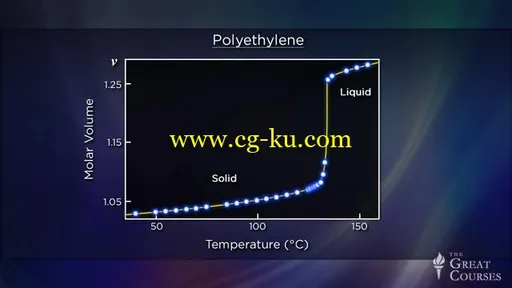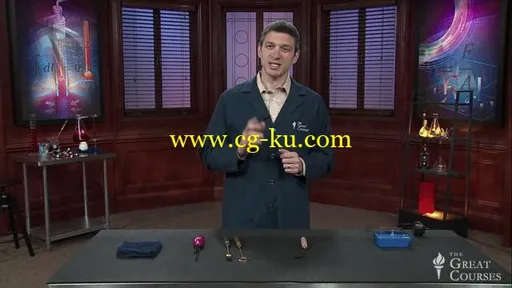
TTC Video - Thermodynamics: Four Laws That Move the Universe
English | wmv | wmv9 640x360 2000 kbps | WMA 2 ch 128 kbps | 12 hrs 36 min | 9.46 GB
eLearning | Course No. 1291
What is heat? What is temperature? What is energy? What is time? When we look beneath the surface of these everyday terms to learn how scientists understand them, we encounter a realm of fundamental processes that
rule the universe.
This is the domain of thermodynamics, the branch of science that deals with the movement of heat. Nothing seems simpler, but nothing is more subtle and wide-ranging in its effects. And nothing has had a more profound impact on the development of modern civilization.
Thermodynamic processes are at the heart of everything that involves heat, energy, and work, making an understanding of them indispensable for careers in engineering, physical science, biology, meteorology, and even nutrition and culinary arts. Consider these applications of the laws of thermodynamics:
- The Industrial Revolution in the 1700s harnessed fire and fuel to produce power, leading to new forms of manufacturing, transportation, and the breathtaking array of technologies we have today—thanks to a mastery of thermodynamics.
- New advances in alternative energy, fresh water production, materials science, communication, computing, and a host of other fields are in the works as thermodynamic processes are being applied at scales as small as the quantum realm.
- Thermodynamic concepts play a pivotal role in understanding the evolution and fate of the universe. The second law of thermodynamics led to the discovery of entropy, which explains the arrow of time and the unidirectionality of all processes.
- In daily life, thermodynamics explains why salt melts ice, why conventional car engines are so inefficient, and why the cheese on a hot slice of pizza burns the roof of your mouth, but the crust at the same temperature doesn’t.
When Albert Einstein contemplated the laws of thermodynamics, he was awestruck. “It is the only physical theory of universal content that … will never be overthrown,” he wrote. Of the famous second law, the English scientist and novelist C. P. Snow cited it as equal to Shakespeare’s plays in its importance to the cultural literacy of every educated person.
Thermodynamics: Four Laws That Move the Universe gives you an in-depth tour of this vital and fascinating science in 24 enthralling lectures that are suitable for everyone from science novices to professionals in the field who wish to review elementary concepts and formulas. Your teacher is Professor Jeffrey C. Grossman of the Massachusetts Institute of Technology, a scientist at the forefront of research on new materials with applications in energy conversion, energy storage, and clean water.
Four Far-Reaching Laws
The four laws of thermodynamics describe how energy moves, why it changes from one form to another, and how matter is affected during these transformations. You begin with the zeroth law (so named because it is fundamental to the other laws), which defines the concept of temperature in terms of thermal equilibrium. The first law is a declaration of the conservation of energy principle. The second law explains why heat always flows from hot to cold. And the third law deals with the impossibility of reaching absolute zero.
With these laws as a launching point, you learn foundational concepts that are critical pillars of science and engineering—ideas such as entropy, chemical potential, Gibbs free energy, enthalpy, osmotic pressure, heat capacity, eutectic melting, and the Carnot cycle. These and other ideas shed light on many phenomena in the natural world, and they are the analytical tools that engineers use to create new devices and technologies.
Professor Grossman cites the cell phone as an example. Of the approximately 100 stable elements found in nature, the typical cell phone uses 64, each chosen to perform a specific function based on its thermodynamic properties, and each laboriously extracted from the earth and processed to do its job.
Seeing Is Believing!
Professor Grossman is a born educator and showman. In nearly every lecture, he puts on his lab coat and goggles and smashes, breaks, ignites, or otherwise converts energy from one form into another—showing thermodynamics in action.
Thermodynamics is also illustrated with scores of informative diagrams, animations, and simple equations that add depth and clarity to the presentation. For example, you learn how phase diagrams are a powerful tool for discovering how temperature, pressure, and other variables affect the solid, liquid, and gaseous phases of matter. Professor Grossman compares phase diagrams to the GPS unit on a car: They tell you exactly where you’re going when you apply different conditions to a material.
Intriguingly, phase diagrams reveal that water and other liquids have a “triple point,” where they can simultaneously freeze and boil. Professor Grossman demonstrates this astonishing phenomenon on camera. Some of his other eye-opening experiments include the following:
- Work = heat: The first law of thermodynamics relates heat to mechanical motion. See how a piece of cotton can be set afire by striking a piston with a hammer, thanks to the change from work to heat, which is explained by an equation called the ideal gas law.
- When 1+1 doesn’t equal 2: Combine 50 milliliters of water with an equal volume of ethanol and you get 97—not 100—milliliters of the combined solution. Ethanol molecules are able to fit inside open spaces between water molecules—an illustration of the thermodynamic concept of partial molar volume.
- Alternative engines: We are all familiar with heat engines that extract power from burning fuel, such as the internal combustion engine. But there are many other ways to convert energy into work. See how engines can be built so they are powered by magnetism, phase change, entropy, and surface tension.
- Potato battery: Insert a copper wire and a zinc wire into a potato. Connect the wires to an LED. Voila: light! Where is the electricity coming from in this demonstration of electrochemical energy? What is the role of the potato? The answers may surprise you.
You will also see a balloon resist popping while held in a flame, a hundred dollar bill set on fire without charring, and a massive 10-foot-high eruption caused by a very simple chemical reaction. Each of these experiments is designed to make the challenging concepts of thermodynamics memorable and intuitive.
At the end of Thermodynamics, Professor Grossman gives a glimpse of his own pioneering research on clean energy and water. Having come this far in the course, you will truly appreciate his excitement over innovative solar thermal fuels and desalination membranes, both based on thermodynamic principles. Best of all, you will understand how and why they work!
24 Lectures
1 Thermodynamics—What’s under the Hood
2 Variables and the Flow of Energy
3 Temperature—Thermodynamics’ First Force
4 Salt, Soup, Energy, and Entropy
5 The Ideal Gas Law and a Piston
6 Energy Transferred and Conserved
7 Work-Heat Equivalence
8 Entropy—The Arrow of Time
9 The Chemical Potential
10 Enthalpy, Free Energy, and Equilibrium
11 Mixing and Osmotic Pressure
12 How Materials Hold Heat
13 How Materials Respond to Heat
14 Phases of Matter—Gas, Liquid, Solid
15 Phase Diagrams—Ultimate Materials Maps
16 Properties of Phases
17 To Mix, or Not to Mix?
18 Melting and Freezing of Mixtures
19 The Carnot Engine and Limits of Efficiency
20 More Engines—Materials at Work
21 The Electrochemical Potential
22 Chemical Reactions—Getting to Equilibrium
23 The Chemical Reaction Quotient
24 The Greatest Processes in the World


发布日期: 2014-03-18